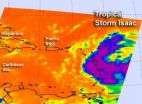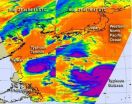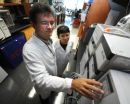(Press-News.org) This press release is available in Spanish.
Formosan subterranean termites could be in for a real headache. U.S. Department of Agriculture (USDA) scientists have identified species of roundworms, or "nematodes," that invade the termite brains and offer a potential bio-based approach to controlling them. Other nematodes that were identified invaded tarantula brains.
The Formosan termite, a nonnative species from Asia, feeds on cellulose from the heartwood of trees, the wood support beams of buildings, and other sources. It causes an estimated $1 billion annually in U.S. damages, repairs and control costs.
Biologically based control of the pest isn't a new concept, but the nematode species examined thus far do not kill the termites efficiently, according to Lynn Carta, a plant pathologist with the Nematology Laboratory, operated in Beltsville, Md., by the Agricultural Research Service (ARS), USDA's chief intramural scientific research agency.
Since 1999, Carta has determined the identities of seven species of nematode isolated from the bodies of Formosan termites by Ashok Raina, a retired entomologist formerly with the ARS Southern Regional Research Center in New Orleans, La. Other specimens Carta has identified were collected from dead or sick termites native to Uzbekistan. Further details appear in the International Journal of Nematology.
Of particular interest to Carta and colleagues are bacteria that have a symbiotic association with the nematodes. In one case, a Poikilolaimus nematode species and bacterial "accomplice" were isolated from the heads of Formosan termites, and it's likely the microbe had sickened the insects in the field. According to Carta, the bacterial association raises an interesting prospect: using nematodes as vectors of insect pathogens rather than as primary biocontrol agents—the traditional approach.
In another case that's still under investigation, Carta implicated a Panagrellus nematode species in the death of pet tarantulas. She suspects an insect and yeast may also be involved and is intrigued by the possibility because it would reveal a new ecological association that could yield novel approaches to pest control.
###Read more about the research in the August 2012 issue of Agricultural Research magazine.
http://www.ars.usda.gov/is/AR/archive/aug12/pests0812.htm
Nematodes with pest-fighting potential identified
2012-08-23
ELSE PRESS RELEASES FROM THIS DATE:
Cramming for a test? Don't do it, say UCLA researchers
2012-08-23
Every high school kid has done it: putting off studying for that exam until the last minute, then pulling a caffeine-fueled all-nighter in an attempt to cram as much information into their heads as they can.
Now, new research at UCLA says don't bother.
The problem is the trade-off between study and sleep. Studying, of course, is a key contributor to academic achievement, but what students may fail to appreciate is that adequate sleep is also important for academics, researchers say.
In the study, UCLA professor of psychiatry Andrew J. Fuligni, UCLA graduate ...
NASA sees Tropical Storm Isaac and Tropical Depression 10 racing in Atlantic
2012-08-23
VIDEO:
This animation of satellite observations from August 19-22, 2012, shows the development and movement of Tropical Storm Isaac toward the Lesser Antilles. This visualization was created by the NASA GOES...
Click here for more information.
There are now two active tropical cyclones in the Atlantic and NASA is generating satellite imagery to monitor their march westward. Tropical Storm Issac is already bringing rainfall to the Lesser Antilles today, Aug. 22, Tropical ...
University of Colorado analysis of election factors points to Romney win
2012-08-23
A University of Colorado analysis of state-by-state factors leading to the Electoral College selection of every U.S. president since 1980 forecasts that the 2012 winner will be Mitt Romney.
The key is the economy, say political science professors Kenneth Bickers of CU-Boulder and Michael Berry of CU Denver. Their prediction model stresses economic data from the 50 states and the District of Columbia, including both state and national unemployment figures as well as changes in real per capita income, among other factors.
"Based on our forecasting model, it becomes clear ...
Double trouble continues in the Philippine Sea: Tembin and Bolaven
2012-08-23
Typhoon Tembin and Typhoon Bolaven continue to churn in the Philippine Sea, and infrared satellite data from NASA showed the power within both storms.
The Atmospheric Infrared Sounder (AIRS) instrument that flies onboard NASA's Aqua satellite captured imagery of both storms on Aug. 21 in two different overpasses. Aqua flies over the same locations during early morning and early afternoon (local time) as it orbits the Earth. Aqua passed over the Philippine Sea on Aug. 21 at 04:41 UTC (12:41 a.m. EDT) and 16:47 UTC (12:47 p.m. EDT). The two satellite passes were combined ...
Scientists from UCLA, Israel's Technion uncover brain's code for pronouncing vowels
2012-08-23
Scientists at UCLA and the Technion, Israel's Institute of Technology, have unraveled how our brain cells encode the pronunciation of individual vowels in speech.
Published in the Aug. 21 edition of the journal Nature Communications, the discovery could lead to new technology that verbalizes the unspoken words of people paralyzed by injury or disease.
"We know that brain cells fire in a predictable way before we move our bodies," said Dr. Itzhak Fried, a professor of neurosurgery at the David Geffen School of Medicine at UCLA. "We hypothesized that neurons would ...
Video shows the traffic inside a brain cell
2012-08-23
Using bioluminescent proteins from a jellyfish, a team of scientists has lit up the inside of a neuron, capturing spectacular video footage that shows the movement of proteins throughout the cell.
The video offers a rare peek at how proteins, the brain's building blocks, are directed through neurons to renew its structure. It can be viewed online here: http://www.youtube.com/watch?v=baI9q2--q7s&feature=youtu.be
"Your brain is being disassembled and reassembled every day," said Don Arnold, associate professor of molecular and computational biology at the USC Dornsife ...
ORNL researchers probe invisible vacancies in fuel cell materials
2012-08-23
Knowing the position of missing oxygen atoms could be the key to cheaper solid oxide fuel cells with longer lifetimes. New microscopy research from the Department of Energy's Oak Ridge National Laboratory is enabling scientists to map these vacancies at an atomic scale.
Although fuel cells hold promise as an efficient energy conversion technology, they have yet to reach mainstream markets because of their high price tag and limited lifespans. Overcoming these barriers requires a fundamental understanding of fuel cells, which produce electricity through a chemical reaction ...
Targeting inflammation to prevent, treat cancers
2012-08-23
Augusta, GA—Researchers at the Georgia Health Sciences University Cancer Center have identified a gene that disrupts the inflammatory process implicated in liver cancer.
Laboratory mice bred without the gene lacked a pro-inflammatory protein called TREM-1 and protected them from developing liver cancer after exposure to carcinogens.
The study, published in Cancer Research, a journal for the American Association for Cancer Research, could lead to drug therapies to target TREM-1, said Dr. Anatolij Horuzsko, an immunologist at the GHSU Cancer Center and principal investigator ...
Elusive metal discovered
2012-08-23
Washington, D.C.—Carnegie scientists are the first to discover the conditions under which nickel oxide can turn into an electricity-conducting metal. Nickel oxide is one of the first compounds to be studied for its electronic properties, but until now scientists have not been able to induce a metallic state. The compound becomes metallic at enormous pressures of 2.4 million times the atmospheric pressure (240 gigapascals). The finding is published in Physical Review Letters.
"Physicists have predicted for decades that the nickel oxide would transition from an insulator—a ...
Northwestern scientists create chemical brain
2012-08-23
Northwestern University scientists have connected 250 years of organic chemical knowledge into one giant computer network -- a chemical Google on steroids. This "immortal chemist" will never retire and take away its knowledge but instead will continue to learn, grow and share.
A decade in the making, the software optimizes syntheses of drug molecules and other important compounds, combines long (and expensive) syntheses of compounds into shorter and more economical routes and identifies suspicious chemical recipes that could lead to chemical weapons.
"I realized that ...


